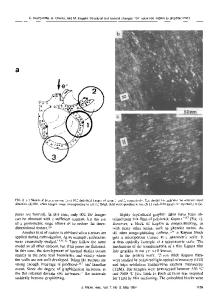A study of temperature and pressure induced structural and electronic changes in SbCl 5 intercalated graphite: Part II.
- PDF / 1,171,257 Bytes
- 12 Pages / 576 x 792 pts Page_size
- 15 Downloads / 345 Views
E. McRae, J. F. Mareche, and M. Lelaurain Universite de Nancy I, Laboratoire de Chimie du Solide Mineral, U.R.A. C.N.R. S. 158, Service de Chimie Minerale Appliquee, B. P. 239, 54506 Vandoeuvre-les-Nancy Cedex, France (Received 26 March 1992; accepted 6 July 1992)
We present experimental data for the c-axis resistivity pc of stage s = 2, 3, 4, 5, and 8, SbCl5 intercalated graphite, over the temperature range 40 to 300 K and the pressure range 0 to 0.8 GPa ( 0 - 8 kbar). For most specimens studied, resistance anomalies are observed below 230 K at atmospheric pressure and at pressures up to 0.5 GPa at 293 K. These anomalies are explained in terms of structural changes from a disordered or partly crystallized in-plane intercalate structure at atmospheric pressure and T > 230 K to an almost completely crystallized structure below this temperature, or at elevated pressures, as discussed in a companion paper. In the crystallized phases pc is approximately linear in T except for stage 8, for which a nonlinear behavior, with a negative temperature coefficient of resistivity below 200 K, is observed. The results are compared with previously available literature data, and the p-T phase diagram is briefly discussed.
I. INTRODUCTION Of all graphite intercalation compounds (GIC's) examined during the past ten to fifteen years (for reviews, see Refs. 1-5), the pentahalide GIC's have been the subject of particularly intense study due to their initial promise of high in-plane electrical conductivity6 and to the large variations in structure and properties as functions of preparation conditions, stage number, s, temperature, T, and pressure, p. (The stage number s indicates the number of graphene layers between successive intercalate layers.) Among these compounds, SbCis GIC's are probably the most widely investigated because of their stability in dry air. A large number of papers has been written on various aspects of the structures observed in the SbCl5 GIC family (see Refs. 8 to 25 in Ref. 7), but as yet no consensus has been reached even as to which chemical species are actually present in the materials after the disproportionation reaction occurring during intercalation: 3SbCl, + 2e~
SbCl,
2SbCl 6 ".
(1)
This question has recently been treated in Refs. 8 and 9. The in-plane structures of these materials have been discussed in detail in a companion paper,7 hereafter referred to as paper I, and this discussion will not be repeated here. As regards the electronic properties of SbCl5 GIC's, studies of the thermoelectric power (TEP) show that stage 1 to 10 materials are hole conductors.10 Measurements of the optical reflectivity11'12 and de HaasJ. Mater. Res., Vol. 7, No. 11, Nov 1992 http://journals.cambridge.org
Downloaded: 27 Mar 2015
van Alphen effect studies13 l s indicate a charge transfer of 0.4 ± 0.15 holes per intercalated SbCl5 molecule, significantly less than the 2/3 per molecule given by Eq. (1) for the case of complete disproportionation. As discussed in paper I, the intercalated molecules can form fully cryst
Data Loading...











